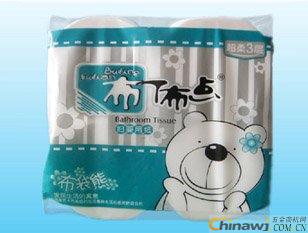What did the toilet paper burning method get?
Secondary pollution refers to used sanitary napkins, newspapers and other waste papers. After being recycled and bleached, it is illegally manufactured by some small processing factories or black dens and finally distributed to the market. The standard of healthy toilet paper is to resolutely eliminate secondary pollution!
In addition to the sense of mission and responsibility of a company, real healthy tissue paper needs a strong industrial base, advanced processing equipment and processing technology. Toilet paper is for everyone, adults, and children’s daily necessities.
Health standards are very important! To put it bluntly, the standard of healthy household paper is actually very simple, that is, the selection of high-quality raw materials, and optimization of the process in the process of processing, to prevent secondary pollution, and to undergo special disinfection and sterilization.
When it comes to the quality identification of toilet paper, one method that is very popular on the Internet is the toilet paper burning method. But is this really the case? The tar-like substances produced are rather rare. Therefore, this method determines the quality of the toilet paper based on whether or not the toilet paper is burned after burning.
Baoding Xinli Paper Co., Ltd. (**: http://) All for the customer, for the customer's everything, to make customers satisfied and happy, at the same time we recruit toilet paper agent manufacturers, interested friends call us.
Http://news.chinawj.com.cn
 Submission:
Submission: 
|
Chemical formula: |
|
|
Molecular weight: |
172.09 |
|
Standard executed: |
GB/T 28159-2011 GB3149-2004/FCC GB/T 2091-2008 |
|
Properties: |
Under normal temperature, Phosphoric acid is a colorless transparent viscous liquid, with a melting point of 21.1℃ and a boiling point of 158 ℃. As a tribasic acid with moderate acidity, it has all the common characteristics of an acid, including strong metal corrosion properties. |
|
Usage: |
1.Phosphoric acid Electronic Grade is widely used in the semiconductor industry in ultra large scale integrated circuits, electronic chips, liquid crystal display films and cleaning and etching of said products. It is also used in the preparation processes of high purity special phosphates and high purity organic phosphorus products. 2.Phosphoric Acid Food Grade is used as a clarifier in food and beverage industries, as an acid additive or a yeast nutrient, and in the production of food grade phosphates. 3.Mainly used as a metal surface treatment agent, as the phosphate in raw material products, as an organic reaction catalyst in the sugar industry and as a refractory additive or a activated carbon treatment agent in the compound fertilizer industry. |
|
Packaging and storage: |
Electronic Grade:Packaged in 200L HDPE drums(330Kg / drum), IBC ton barrels (1700 Kg /drum), or the ISO lorry lined in 316L stainless steel. Food grade:1000L IBC (1700KG/tank,IBC),200L drum (330KG/drum),25L drum(35KG/drum) and ISO-TANK. Store in a cool, dry, well-ventilated area away from toxic and hazardous Tech grade:1000L tank(1700KG/tank, IBC);200L plastic drum (330KG/drum);25L plastic drum(35KG/drum) and ISO-TANK. |
Phosphoric Acid CAS NO.7664-38-2
wc-reiniger,EVITs,H3PO4,PHOS ACID,MFCD00011340,Phosphoric,Marphos,Phosphorous acid,U.N. 1805,( 1527873,R)-VAPOL phosphoric acid,VAPOL hydrogenphosphate
Jinan Forever Chemical Co., Ltd. , http://www.jinanforever.com